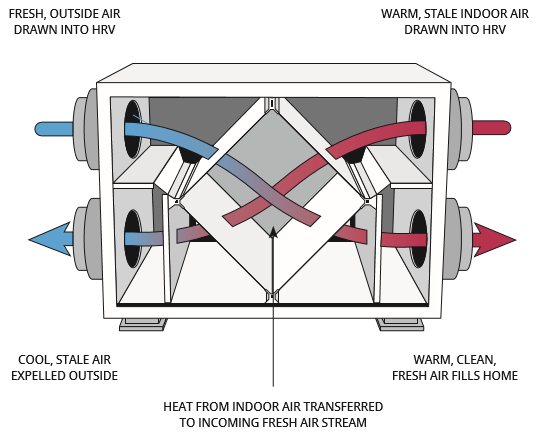How HRV Creates a Comfortable Indoor Living Environment
Checking out the Benefits of Heat Recovery Ventilation for Energy Effectiveness in Homes
Heat Recovery Ventilation (HRV) systems supply house owners a sensible technique to boosting energy efficiency. By redeeming heat from outward bound air, these systems can significantly reduce cooling and heating costs. In addition, they offer a steady supply of fresh air, enhancing indoor air top quality and comfort degrees. As home owners take into consideration sustainable options, comprehending the nuances of HRV systems becomes increasingly vital. What aspects should one examine prior to making such a financial investment?
Recognizing Heat Recovery Ventilation Solutions

Just How HRV Enhances Indoor Air High Quality

Energy Savings: The Monetary Advantages of HRV
Making best use of power effectiveness, heat recovery ventilation (HRV) systems offer considerable financial benefits for home owners. By recuperating and reusing warm from exhaust air, HRVs considerably decrease cooling and heating costs. This technology anonymous can result in energy cost savings of approximately 30%, relying on climate and use patterns. Home owners frequently see decreased utility bills soon after setup, making HRVs a monetarily sensible financial investment gradually. In addition, many areas give incentives or refunds for energy-efficient upgrades, additionally boosting the economic allure. As energy costs more helpful hints continue to climb, the cost-effectiveness of HRVs comes to be progressively clear. Overall, the unification of HRV systems not just promotes power efficiency but additionally adds to lasting monetary savings for homes.
The Environmental Impact of Heat Recovery Ventilation
A substantial environmental advantage of heat recovery ventilation (HRV) systems lies in their ability to lower overall power usage. By reclaiming warm from exhaust air and moving it to inbound fresh air, HRV systems decrease the requirement for energy-intensive heating and cooling approaches. This reduction in energy demand adds to decrease greenhouse gas emissions, as much less fossil fuel is required to keep comfy interior temperature levels. Additionally, HRV systems enhance interior air high quality by successfully trading stagnant air with fresh outside air, reducing dependence on mechanical cooling systems that can damage the atmosphere. Generally, the application of HRV systems sustains lasting living methods and aligns with global efforts to combat climate change by promoting energy performance in residential setups.
Picking the Right HRV System for Your Home
Exactly how can property owners assure they choose the ideal heat recovery ventilation (HRV) system for their demands? Initially, they ought to analyze their home's size and layout, as see this here these factors influence air flow requirements. Next off, reviewing the system's effectiveness scores is essential, as higher ratings indicate much better efficiency and power financial savings. Homeowners need to also consider installation and maintenance prices, comparing different brand names and models for worth. In addition, it's vital to examine noise levels, as some systems run even more silently than others. Consulting with a/c professionals can supply tailored suggestions based upon certain home problems. Lastly, taking a look at customer reviews and warranties can assist in making a notified decision, making sure that the selected HRV system properly boosts indoor air high quality and energy performance.
Often Asked Concerns

How Often Should I Clean or Preserve My HRV System?
The regularity of cleansing or preserving a warmth recuperation ventilation (HRV) system typically depends upon use and ecological variables. Normally, it is suggested to do maintenance every six months to guarantee peak efficiency and air high quality.

Can HRV Solutions Help In Reducing Humidity Degrees Inside?
HRV systems can effectively minimize indoor humidity degrees by trading stagnant, humid air with fresh, drier air from outside. HRV Heat Recovery Ventilation. This procedure aids maintain a balanced indoor atmosphere, enhancing convenience and stopping moisture-related concerns
What Is the Lifespan of a Common HRV System?
The lifespan of a typical heat recovery ventilation (HRV) system differs, normally lasting in between 10 to 15 years. Routine upkeep can prolong its performance and operational life, making sure peak performance throughout its usage duration.
Are There Any Type Of Noise Worries With HRV Equipments?
Sound interest in HRV systems can develop, specifically from fan operation. Nevertheless, numerous modern devices are developed to reduce sound levels, guaranteeing they run quietly while keeping performance, which addresses possible disturbances in living settings.
Can I Set Up an HRV System Myself, or Do I Need a Professional?
The individual contemplated whether to mount the heat recovery ventilation (HRV) system personally or work with an expert. Usually, while DIY installment is possible, expertise guarantees correct functionality and conformity with neighborhood building ordinance, boosting system performance.